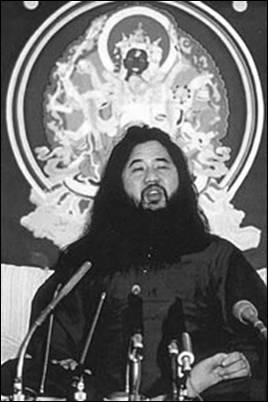A passage from the April 3, 1995 edition of Time magazine about the scary rise to prominence of Shoko Asahara, the nearly blind cult leader who poisoned Tokyo subways with Sarin gas in 1995 and currently awaits execution:
“By 1984, though, the future ‘savior’ began to find his niche. He set up a yoga school that proved to be quite successful. Even if a former student recalls that in those days ‘we were not followers but members,” the time was ripe for gurus. Japan’s galloping economic miracle in the 1970s and ’80s also spawned a boom in ‘new religions’ offering spiritual refuge to Japanese alienated by materialism. Asahara’s messianic self-image expanded to help fill this void. After a visit to a Himalayan retreat, he boasted of having achieved satori, the Japanese term for nirvana or enlightenment. At this point he also claimed his first success at self-levitation.
Asahara established his Aum Shinrikyo religion in 1987, and the movement even put up a number of candidates in the 1990 Lower House Diet elections; all of them lost. Not much later he began conferring on himself such titles as ‘Today’s Christ’ and ‘the Savior of This Century.’ His community branched out rapidly in Japan. Soon it had established some beachheads overseas–including the U.S. and Germany but notably Russia. Asahara once preached before a crowd of 15,000 in a Moscow sports stadium.
As his fortunes prospered, Asahara seems to have grown more reclusive and obsessed with danger. The religion, nominally Buddhist but really a hodgepodge of ascetic disciplines and New Age occultism, focused on supposed threats from the U.S., which he portrayed as a creature of Freemasons and Jews bent on destroying Japan. The conspiracy’s weapons: sex and junk food. The guru’s sermons predicted the end of the world sometime between 1997 and 2000, and began citing the specific peril of poison-gas attacks.”
••••••••••
“Someone or some group mounted a devastating posion gas attack this morning”:
Aum Shinrikyo anime:

